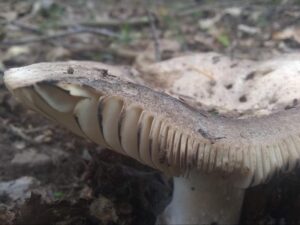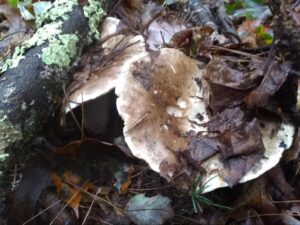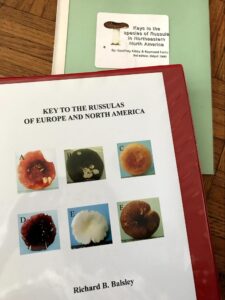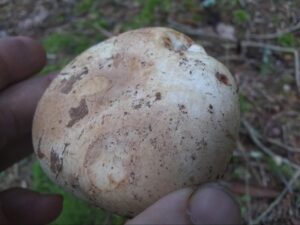
A common and basic question regarding wild mushrooms is: how do you know if it is edible? This is especially important in survival situations. It is best if you already know something edible. But what if you don’t? Is there a safe way to figure out if something unknown is edible?
I looked up the universal edibility test and found an extract from the U.S Army Survival Manual. In a special warning box it states: Do not eat mushrooms in a survival situation! The only way to tell if a mushroom is edible is by positive identification. There is no room for experimentation. Symptoms caused by the most dangerous mushrooms affecting the central nervous system may not show up until several days after ingestion. By that time, it is too late to reverse their effects.

While this is sound advice, it is also a beginner’s warning. We want to get a little deeper than that. Let’s do so with a discussion of Russula, a large genus of mushrooms with much to talk about regarding edibility… as well as much to learn! You will not hear lots about Russula as food, as they are generally not as celebrated as some other edibles more commonly thought of as “choice”. Yet, some are choice, many are edible, and they are among the most commonly encountered mushrooms (at least in northeastern North America, and in many other places).
Are Russula Good To Eat?

While Americans commonly ignore the Russula species as food, some cultures eat them regularly. Russula is very well known to folk knowledge. Typically, traditional wisdom informs us that spicy ones should be avoided while mild flavors are okay. Oh yeah, and at least one group is seriously poisonous – the Red-Staining, or Blackening, Russula (more about this later).
As my childhood neighbor, Mrs. Sebris, told me, “If it bites, don’t eat it.” Many Russula species are spicy and generally these are the ones avoided. But is that safe to go by? I have heard such guidance from many others as well, and not just people from Latvia (though most Russula lovers I have met do come from that general part of the world). Besides the taste, many Russula mushrooms are avoided as edibles because of their delicate texture. One of the distinguishing qualities of Russula is a crumbly cell structure that causes them to break easily. But this is highly variable. Some thin species would just crumble into just about nothing if cooking were attempted. But stout species, though maybe having brittle gills or a stem that snaps like chalk, can have a very firm and desirable texture. Some edible species, such as Russula compacta, are avoided simply because they don’t taste good.

The discussion of the various species of Russula, their identification, and their edibility (and toxicity) will be expanded on in future articles. For now, I want to get back to the subject of mushrooms (in general) as survival foods.
Mushrooms as Survival Foods
Sometimes mycologists like to define cultures as mycophobic or mycophilic. Mycophobe groups, according to general theory, have culturally developed an innate fear of mushrooms, likely because of exposure to a relatively large number of deadly poisonous mushrooms. Mycophilia, on the other hand, arises when collective experience has lead to a favorable attitude towards mushrooms. There are many reasons people have learned to love, and even revere mushrooms, but one central idea is that mushrooms played the important role of food during times of scarcity.
It is not difficult to imagine that during years of heavy rain in ancient times, people would suffer crop failures (actually, many farmers experienced such a year this past season). Such years could also give rise to abundant wild mushroom fruiting. Edible wild mushrooms are very nutritious. Since conducive conditions can support extremely abundant “fruitings” of wild mushrooms – with entire hillsides speckled with mushrooms and certain mushrooms growing over 100 pounds – the food value can be significant.
Nutritional Consideration
Mushrooms are low in fat. While this makes them prime candidates for consideration as health foods, it can also be an important deficiency to consider in a survival situation. A diet based on mushrooms needs a source of fat.
I have experienced many periods of eating a large amount of mushrooms.

What I mean by a large amount is mushrooms as the main course or bulk food for 1 to 3 meals a day for more-or-less days in a row. Oftentimes, when blessed with abundant harvests I eat meals that consist almost entirely of cooked mushrooms. Generally I cook them with cooking oil and use some Allium or wild green (sansai). I find this amazingly satisfying and energizing. I have found during such times that my energy level improves, my general sense of health improves, and that I am very satisfied by it. I have talked to many others about this who have had similar experiences.
I also like to prepare mushrooms as soup, which I also find very satisfying and health-promoting. In this case, I like to include some fish or game, which provides fat.
Developing Mushroom Hunting Skills Is An Important Preparatory Study
Being able to find and being able to identify mushrooms could be extremely helpful in a survival situation. As was discussed earlier, figuring out if an unknown mushroom is edible is a dangerous survival activity. And like in so many other arenas, a little bit of knowledge is a dangerous thing. For instance, I have heard educators claim that Russula is a safe genus of mushrooms. But, the Reddening Russula (or Black-Staining Russula – Russula subnigricans) attests otherwise.

This brings us to another important point: First (or close to it), learn the most poisonous. If you learn the most poisonous, or what to avoid, than exploration of the less poisonous and the edible becomes much safer.
To benefit from edible mushrooms, you must find them. To hunt for edible mushrooms it often helps to understand certain conditions of their growth, such as season, tree associations (with Russula this mostly pertains to mycorrhyzal relationships), temperature triggers, and pointer plants.
Once found, you must be able to identify the mushrooms to determine their edibility. Future articles will begin to explain the process of identification. If you are interested, definitely begin investing in mushroom books.
Pictured are a couple special books focused specifically on Russula. You will want to start with some general field guides.
Unknown Mushrooms in Survival Situations

Besides the US Army warning (see second paragraph), mushroom lore is full of sayings that warn of the dangers of poisonous mushrooms and the importance of certain identification. Though also used elsewhere (such as among pilots, I am told), there is, “There are old mushroom hunters, and bold mushroom hunters, but no old bold mushroom hunters!” And, “Be 110% sure of identification before eating!” Or, “When in doubt, throw it out!” So, that being clear enough, what about a real survival situation?
Also read: Tree Bark as an Emergency Food
…So, you are starving (or at least feel like it) and far from our lovely globalized food network, and from hope of immediate rescue. You have no known edible plants in sight (which brings us back to the universal edibility test, but that is another subject). Anyway, nothing botanical seems too appealing. No animals in sight, and not much sign of them, and not much hunting or trapping equipment… And you stumble across mushrooms! Lots of mushrooms! How can you tell if you can eat them? I don’t know. And I don’t know if anyone does, besides through the method of identification. But this doesn’t help the non-mycologist who is starving amongst hundreds of mushrooms.
In spite of all the above warnings, Charles McIlvaine’s (the author of One Thousand American Fungi) story is inspiring. But I will have to save that too for a future article, especially since I actually don’t know the story very well. My understanding is that McIlvaine was pretty adventurous in exploring the edibility of mushrooms and tasted hundreds (I think that at the time he published the book he had sampled 600 or 700 species of edible mushrooms.), and lived! Now that’s one for the bold mushroom hunters!

For the sake of everyone involved in this article and for the sake of you, my dear reader, I have to discourage any reckless behavior regarding wild mushrooms. But on the other hand, this is clearly an important subject and I do not, either, want to instill fear. I really just want to encourage some thought on the subject (more than tasting) and further research.
Clearly our ancestors put some effort into discovering what species of mushrooms are edible or poisonous, let us moderners not drop the ball on this too!
Further Reading
A good place to start on the subject of wild mushrooms is in reading about major warning signs. Because of the complexity of the subject and the potential lack of knowledge of the author (of course there is some, but hopefully not so much that their writing becomes dangerously misleading), you should read articles on poisonous mushrooms carefully.
